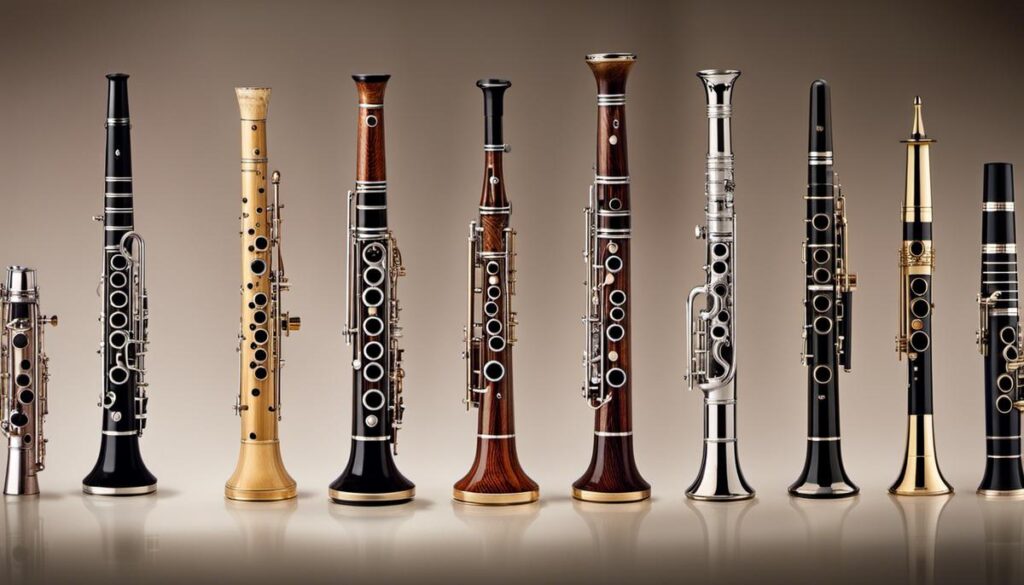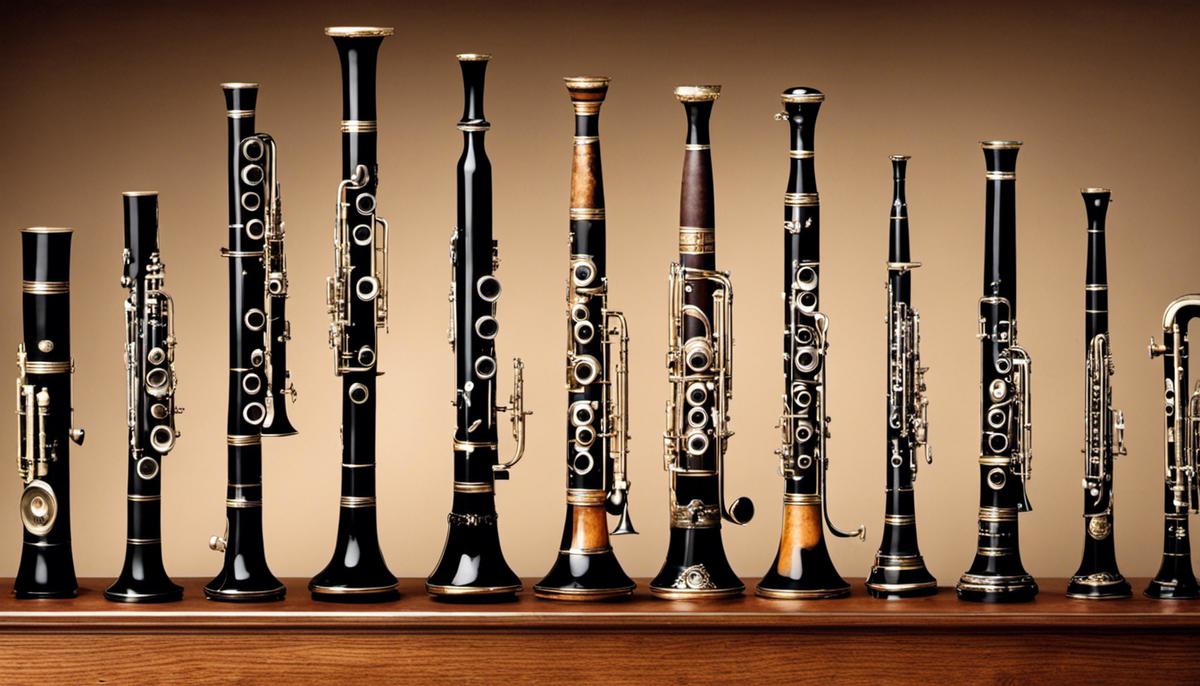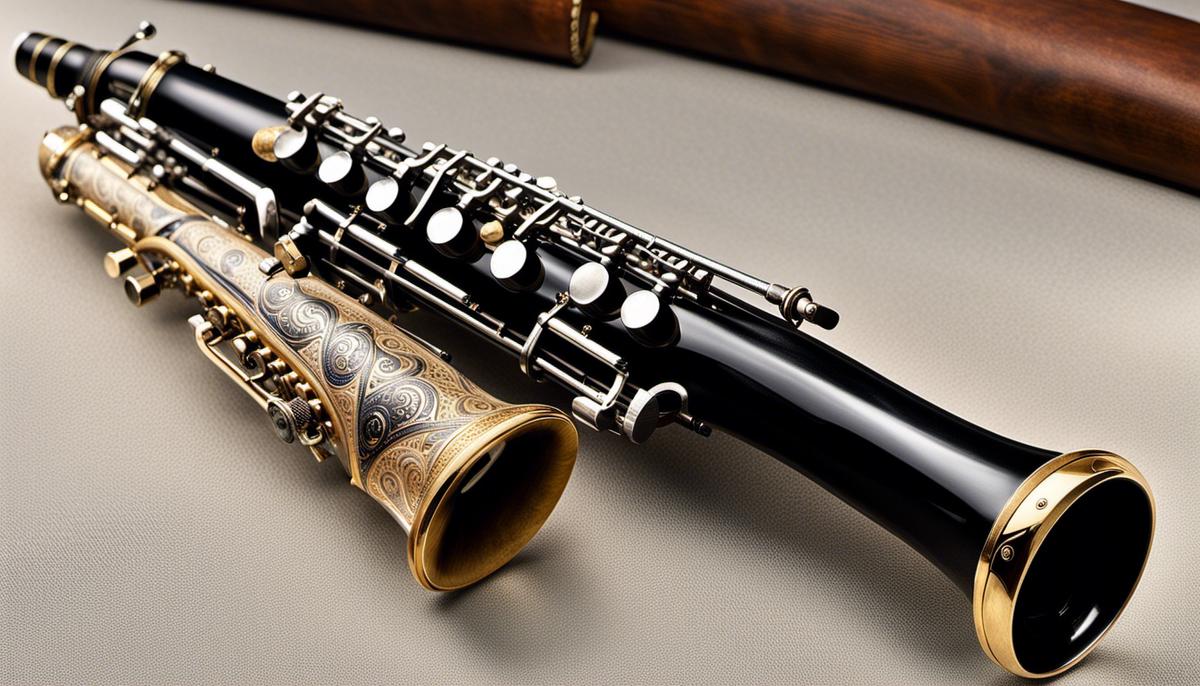Table of Contents
Introduction
The history of the clarinet crosses a diverse genre of music. What started as an innovative product in the inventive hands of Johann Christoph Denner in the late 17th century became a timeless instrument with a beautiful sound.
A segue into its ancestry unravels the chalumeau, evolving into the distinct and sophisticated clarinet, capturing the intrigue of composers in the 18th century. This article explores the clarinet’s background from the classical to the romantic period, and into modern day.
History of the Clarinet
Origins of the Clarinet
The precursors to the modern-day clarinet we know were rather rudimentary devices used in the Ancient world. Yet the most direct ancestor of the clarinet is a wind instrument called the “chalumeau,” which originated in Europe. The chalumeau produced sound when the musician blew into a mouthpiece, causing a single reed to vibrate against a mouthpiece. It was a simple instrument, generally possessing 8 fingerholes and a range of only one and a half octaves.
Johann Christoph Denner and the Inception of the Clarinet
The credit for the invention of the clarinet in the form we know today is attributed to Johann Christoph Denner, a German instrument-maker in the late 17th century. Inspired by the chalumeau, Denner sought to extend its range and versatility. The most significant modification Denner introduced was the addition of a register key. This enabled the clarinet to jump a twelfth (an octave plus a fifth) in tone, as opposed to the octave leap that other woodwind instruments were capable of. This was an unprecedented advancement that gave the instrument a wide range, making it more useful and adaptable.
Technical Advancements and Evolution
Denner’s invention wasn’t an immediate success. The clarinet went through further modifications in the 1700s and 1800s to improve its tonal quality and to adapt it better to the emerging orchestral music of this period. Keys were added, and the shape of the bore and mouthpiece were changed. By the 1800s, with the invention of pad technology, more keys could be added without air leaks, increasing the instrument’s range and versatility even further.
One significant modification was the Boehm system, developed by Hyacinthe Klosé and Auguste Buffet in the 1840s, who were inspired by the mechanisms of the Boehm flute. The Boehm system introduced the use of rings and axles, permitting the coverage of larger holes that produced a warmer, smoother tone. The system is still widely used today, especially for beginners due to its ease and comfort of finger movement.
Clarinet’s Ascendance in the 18th Century
The clarinet’s prominence in the music sphere ascended around the mid 18th century. Renowned composers of the Classical epoch, such as Wolfgang Amadeus Mozart and Ludwig van Beethoven, were enchanted by the clarinet’s distinct tone and ambit. They began incorporating clarinet segments into their symphonies, and even devised exclusive solos and concertos for it. The instrument was indeed an eye-opener, ingeniously bridging the tonal gap between the oboe and the bassoon.
Shortly, the clarinet’s adaptability became vital to the orchestral music globe. By the time the 19th century rolled in, it had become a staple in the symphony orchestra. Its unique ability to deliver a broad spectrum of pitches and evocative sounds – from serene, soft notes to sharp, resonating ones – entranced composers and audiences alike. Thus, the clarinet secured its status in orchestras, ensemble groups, and solo performances.

The Clarinet in Classical & Romantic Period
We can trace the clarinet’s modern form back to the dawn of the 18th century. Yet, it was during the classical and romantic periods, a stretch spanning from mid-18th to late 19th century, that the instrument truly rose to the forefront. These eras marked notable strides in the clarinet’s construction, technical capabilities, repertoire and function in ensemble arrangements. This period of musical evolution was instrumental in establishing the clarinet’s spot in the orchestral and chamber music landscape.
The Clarinet’s Evolution in the Classical Period
The classical period, often associated with composers like Mozart and Haydn, was a time of exploration and innovation for the clarinet. The major change seen during this period was the development of the key system. Prior to this, the clarinet was quite basic, featuring a single reed and holes covered by the fingers. The introduction of keys extended the range of the instrument and improved its intonation and tuning. It also expanded the range of notes that could be played, opening up new possibilities for composers.
One prominent figure in the expansion of the clarinet’s technical capabilities was Anton Stadler, a clarinet virtuoso and friend of Mozart. Mozart was so inspired by Stadler’s abilities that he composed several pieces for the clarinet, including a concerto, a quintet, and trio, thus solidifying the instrument’s role in classical music.
The Clarinet and the Romantic Period
As we move into the Romantic period, the clarinet further transformed, displaying even more keys and a more sophisticated construction. This change in design allowed composers to create more expressive and complex music for the clarinet. The innovations in the instrument’s design – including the introduction of the Boehm system – allowed it to play a full chromatic scale with ease, providing composers greater freedom in their compositions.
Notable composers of the romantic period who wrote for the clarinet include Weber, Brahms, and Schumann. Weber, in particular, was known for utilizing the clarinet’s enhanced range and expressivity to its fullest potential in his concerto and clarinet quintet. Brahms, too, championed the instrument late in his career, writing several pieces that are still staples of the clarinet repertoire today.
Journey of the Clarinet Melodies through the Classical and Romantic Eras
In the annals of musical history, the evolution of the clarinet is marked by its growing prominence and versatility. Resonating strongly from the classical era, is Mozart’s “Clarinet Concerto in A Major,” undeniably considered an iconic representation of this woodwind’s involvement in orchestration.
Transitioning into the Romantic era, the creative contributions of Weber and Brahms further elevated the position of the clarinet. Masterpieces like “Clarinet Concerto No.1” and “Clarinet Concerto No. 2” by Weber, and Brahms’ “Clarinet Quintet” and “Clarinet Trio,” put forth a canvas that illustrated the true flexibility and range of the clarinet.
From its humble beginnings to its stature as an integral element of symphony orchestras, the clarinet’s journey reflects the innovation and creativity of the Classical and Romantic periods. Advances in design married with the demands of accomplished musicians resulted in significant developmental strides that edged the clarinet further into the spotlight. The echoes of its unique voice in classical and romantic music endure, showcasing the unwavering appeal and adaptability of this instrument.

Modern Transformations and Usage
The Clarinet’s Design Revolution in the Late 19th Century
The later part of the 19th century bore witness to a major advancement in clarinet design. The key to this revolution was the Boehm system, primarily developed for flutes but eventually adapted for the clarinet. Created in 1847 by innovators Hyacinthe Klosé and Auguste Buffet, the Boehm system was born from the inspiration of Boehm’s unprecedented key system for flutes. This remodeling introduced significant updates to the classical design, adding to the existing set of keys and rings.
The efficiency of the Boehm system lies in its routine finger patterns, cylindrical bore and enlarged tone holes, all of which grant smooth finger transitions and a uniform sound quality. The design of the Boehm system clarinet, inclusive of a mouthpiece, two joint pieces (both upper and lower), a barrel joint to connect the two, and an expanded end bell, allows for a more ergonomic grip and operation compared to previous models.
Advancements Leading to the Modern Clarinet
Throughout the 20th century and into the 21st, the design and structure of the clarinet continued to evolve, with the introduction of new materials and further refinements to the Boehm system. Synthetic pads began replacing traditional cork or leather, facilitating better maintenance and sound quality. The design of the mouthpiece also evolved over time, with different materials being used such as plastics and hard rubber. The mouthpiece’s internal shape and design continued to be explored and altered at great lengths to improve tone quality and intonation of the clarinet.
Also, the practicality of different finishes was discovered, such as silver and gold, making clarinets not just instruments, but also visually appealing pieces of art.
Role of the Clarinet in Modern Music Genres
As the design of the clarinet evolved, so did its role in various music genres. In the 20th and 21st centuries, the clarinet found an important place in jazz music. Jazz legends like Benny Goodman and Sidney Bechet popularized the clarinet in jazz, with their signature styles that showcased the expressive range of the instrument. The clarinet’s unique tonality makes it fitting for playing the blue notes characteristic of jazz.
Besides jazz, the clarinet also found its way into pop music. The Beatles, for instance, used the clarinet in several of their songs. A significant use of the clarinet can also be found in the works of popular bands like Supertramp and Pink Floyd.
In contemporary classical music, the clarinet has played a significant role as well. Composers like Aaron Copland wrote works that showcased the clarinet’s wide range. Meanwhile, John Williams, notable for his film scores, opted to make use of the clarinet’s emotive capabilities in his compositions, thereby creating memorable and emotive pieces.
Conclusion
In conclusion, the clarinet has seen a significant transformation from the late 19th-century redesign known as the Boehm system. This evolutionary process led to numerous modern adaptations and has cemented its place in various music genres. The constant innovation and evolution of the clarinet account for its distinct timbre, expressive potential, and extensive influence on a variety of music historical contexts. Today, the instrument stands out with its broad genre-spanning role and profound impact on different musical forms.

Influential Clarinetists and their Contributions
Early Clarinet Innovators
Transitioning back to the early phases of its development, the clarinet owes a significant debt to Johann Simon Hermstedt (1778-1846), an illustrious clarinet virtuoso from Germany. His exceptional skill and demand for more sophisticated instruments to showcase his advanced repertoire led him to collaborate with instrument maker Heinrich Grenser. This fruitful partnership resulted in the creation and subsequent introduction of the 13-key clarinet—an instrumental milestone in clarinet history. Hermstedt’s influence remains enduring; his collaborative efforts not only changed the clarinet’s technical abilities but also enriched its tonal quality.
The Premier Clarinetist of the Romantic Era
In the Romantic era, Richard Mühlfeld (1856-1907) emerged as a key figure. As a German clarinetist, Mühlfeld’s lyrical and expressive playing caught the attention of the famous composer Johannes Brahms. Mühlfeld’s unique playing style inspired Brahms to come out of retirement and compose several key pieces specifically for the clarinet, which includes the Quintet in B minor. Brahms called Muhlfeld his “nightingale”, revealing his admiration for Mühlfeld’s beautiful tone and interpretation. This collaboration between Brahms and Mühlfeld significantly broadened the clarinet repertoire during the romantic era.
Saxophone Influence on the Clarinet
At the turn of the 20th century, Sidney Bechet, originally a clarinetist, brought profound changes to clarinet music by marrying the expressive capabilities of the saxophone with the clarinet. His rich, vibrant, and expressive sound resonated with the momentum of Jazz Age, contributing to the evolution of jazz music. His virtuosic performances and recordings left a lasting mark on both the jazz world and the history of the clarinet.
Modern Approaches to Clarinet Playing
In the contemporary era, Benny Goodman (1909-1986), known as the “King of Swing”, came to prominence. Goodman’s fluid technique and sensitivity to jazz rhythms made him one of the most influential clarinetists in the swing era. His landmark concert at Carnegie hall in 1938 played a significant role in establishing jazz as a legitimate form of music.
Another modern innovator in clarinet playing is Richard Stoltzman. Known for his technique and versatility, Stoltzman is regarded as a key figure in bringing the clarinet to the forefront of classical solo instruments. His blend of jazz and classical styles pushed the boundaries of the clarinet repertoire and prompted the creation of new compositions for the instrument.
Each of these influential clarinetists have left a lasting impression on the history of the clarinet. Their innovation in playing techniques, collaborations with composers, and musical contributions have shaped the evolution of the clarinet and broadened its repertoire, enabling future generations to continue exploring the instrument’s possibilities.

Conclusion
The clarinet’s adaptation, transformation, and use in sundry music genres from pop to jazz and contemporary classical music, even unto this 21st century, is a testament to its timeless status within the global music landscape. Its evolution did not result from spontaneous progress but was rather sculpted by the proficiency and creativity channeled by influential clarinetists across several eras.
Their monumental performances, introduction of new playing techniques, and the conception of unique music specifically for the instrument propelled the clarinet into an unprecedented trajectory. Therefore, the clarinet is undeniably an enduring symbol of music’s transcendent power and a testament to the innovative instinct inherent in our human experiences.
Additional Reading
Take some time to check out our other articles:
- Clarinet vs Saxophone
- Mastering French Horn Technique
- Composer Highlight: Caroline Shaw
- Composer Highlight: Johann Johannson
Breve Music Studios publishes music to Spotify, YouTube Music, Amazon Music and more. Follow our pages on Facebook, Instagram, Twitter, TikTok, and YouTube.
Listen to our ensembles: Breve Orchestra, Breve Music Ensemble, Breve Low Brass Ensemble, Breve Woodwind Ensemble, and Jermaine Harris on Spotify.

